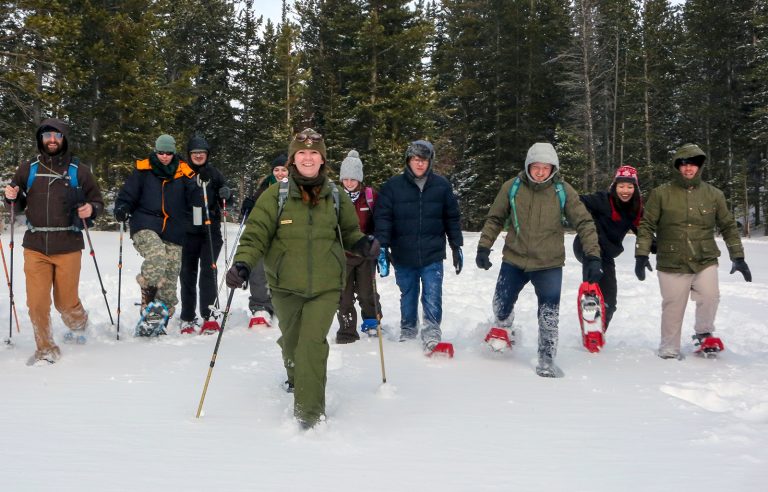
Use snowshoes when walking or hiking on deep snow to prevent sinking and provide better traction. Snowshoes are essential in snowy conditions to avoid getting stuck or facing difficulty while moving.
When there is heavy snowfall or you plan to venture into snowy landscapes, snowshoes allow you to traverse through the snow with ease and safety. Walking without snowshoes in deep snow can be strenuous and tiring, making each step an arduous task.
Snowshoes distribute your weight over a larger surface area, allowing you to “float” on top of the snow, alleviating the strain on your legs and reducing the risk of injury. By wearing snowshoes, you can explore winter wonders and enjoy outdoor activities without the limitations of deep snow slowing you down.
Understanding When to Use Snowshoes
Understanding snowshoes and their benefits and purpose are essential for knowing when and how to use them. Snowshoes are specially designed footwear that distribute the weight of a person over a larger surface area, preventing them from sinking into deep snow. They provide better traction and stability, allowing for easier movement and exploration in snowy terrain.

Snowshoes work by creating a platform that disperses the weight and reduces the pressure exerted on the snow. This functionality enables individuals to walk, hike, or engage in activities like snowboarding and back country skiing in deep snow conditions.
Snowshoes also offer benefits such as improved endurance, cardiovascular workout, and the ability to traverse otherwise inaccessible areas during winter. Whether for recreational purposes or professional use, knowing the benefits and understanding how snowshoes work empowers one to make the most of this essential winter gear.
How Much Snow Do You Need To Snowshoes
Snowshoes are a valuable tool for navigating through snowy terrain. The decision to use them depends on various factors. One crucial factor is the snow conditions. If the snow is too deep or powdery, walking without snowshoes can be exhausting, as you sink into the snow with every step. Snowshoes provide extra surface area, spreading your weight and preventing you from sinking.
Terrain and trail types are also important considerations. If you plan to hike on steep slopes or traverse icy surfaces, snowshoes will provide the necessary traction and stability. They are particularly useful for off-trail exploration and accessing areas that are inaccessible by regular footwear.
Overall, using snowshoes is most beneficial in deep snow, powdery conditions, steep slopes, and off-trail adventures. By using snowshoes in the right snow conditions and terrains, you will enhance your outdoor experience and enjoy winter exploration to the fullest.
Snowshoeing For Adventure And Fitness
Snowshoeing is a great way to enjoy adventure and fitness during the winter months. Whether you’re interested in winter hiking and exploring or cross-country travel, snowshoes provide the necessary support and stability for these activities. They allow you to navigate through snowy terrains by distributing your weight over a wider surface area, preventing you from sinking into the snow. This makes it easier to traverse steep slopes, deep snow, and uneven terrain.
Snowshoes are particularly useful for cross-country travel, as they allow you to move efficiently across snowy landscapes. They are designed to provide flotation, traction, and stability, making it possible to explore snowy trails, forests, and mountains with ease. Additionally, snowshoeing is a low-impact cardiovascular activity that offers a great workout for your legs, back, and core muscles. It’s a fun and accessible way to stay active during the winter while enjoying the beauty of nature.

Credit: issuu.com
Safety Tips And Techniques
Proper Snowshoe Selection and Sizing
Basic Snowshoeing Techniques
|
Additional Winter Gear And Accessories
When it comes to exploring snowy landscapes, snowshoes are an essential piece of winter gear. Snowshoes provide traction and stability, allowing you to walk on deep snow without sinking. But in addition to snowshoes, there are several other accessories that can enhance your winter adventures.
Before venturing out into the cold, make sure you have the right clothing to keep you warm and protected. Here are some cold weather clothing essentials:
- Insulated and waterproof boots to keep your feet dry and warm
- Layered clothing, including a moisture-wicking base layer, an insulating mid-layer, and a waterproof outer layer
- A warm hat or beanie to prevent heat loss from your head
- Gloves or mittens to protect your hands from frostbite
- Thermal socks to keep your feet cozy
In addition to wearing the right clothing, there are a few must-have accessories that can enhance your snowshoeing experience:
- Trekking poles to improve balance and provide additional support
- Gaiters to protect your legs and calves from snow and moisture
- An insulated water bottle or hydration pack to stay hydrated on the trail
- A headlamp or flashlight for visibility during early morning or late afternoon hikes
- A backpack to carry essentials such as snacks, extra layers, and a map
By investing in the right gear and accessories, you can make the most of your snowshoeing adventures and enjoy the beauty of winter landscapes.
Users and Our Expert on When To Use Snowshoes
How Deep Does Snow Have To Be To Go Snowshoeing?
You can go snowshoeing with a snow depth of at least 6 inches.
Do I Really Need Snow Shoes?
Yes, snowshoes are necessary for walking on snowy terrain. They provide better traction and prevent you from sinking in the snow. So, if you plan to hike or move around in snowy areas, snowshoes are essential to make your journey easier and safer.
What Shows Do You Wear Snowshoeing?
For snowshoeing, it’s important to wear appropriate footwear that provides traction and warmth. Opt for waterproof, insulated boots with good grip. Layer up with moisture-wicking socks, thermal pants, and a breathable jacket. Don’t forget a hat, gloves, and sunglasses for sun protection.
Do You Wear Your Own Boots When Snowshoeing?
Yes, you can wear your own boots when snowshoeing. It is not necessary to buy special boots for snowshoeing.
Conclusion: When To Use Snowshoes
Snowshoes are an essential tool for navigating snowy terrains. They provide traction, prevent sinking, and distribute weight evenly. Whether you are hiking, trail running, or exploring backcountry, snowshoes offer improved mobility and safety. Remember to choose the right pair based on your activity and snow conditions.
Don’t let the winter weather stop you from enjoying the great outdoors; embrace the snow with snowshoes!
